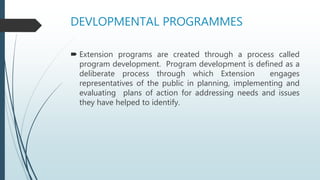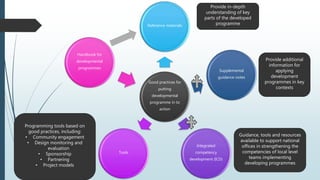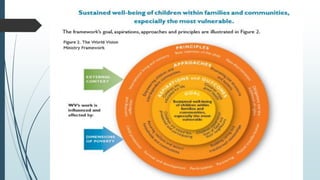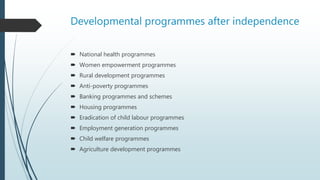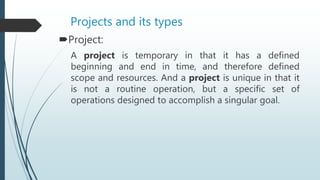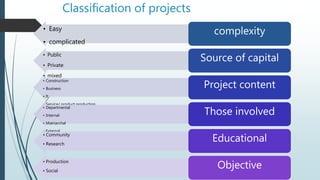Developmental programmes and projects
- 1. Concept of developmental programmes; types of projects; development of research projects Submitted by, Pavithra N., Dept. of HDFS, I.C. COHS
- 2. DEVLOPMENTAL PROGRAMMES ’é┤ Extension programs are created through a process called program development. Program development is defined as a deliberate process through which Extension engages representatives of the public in planning, implementing and evaluating plans of action for addressing needs and issues they have helped to identify.
- 3. Good practices for putting developmental programme in to action Reference materials Supplemental guidance notes Integrated competency development (ICD) Tools Handbook for developmental programmes Provide in-depth understanding of key parts of the developed programme Provide additional information for applying development programmes in key contexts Guidance, tools and resources available to support national offices in strengthening the competencies of local level teams implementing developing programmes Programming tools based on good practices, including: ŌĆó Community engagement ŌĆó Design monitoring and evaluation ŌĆó Sponsorship ŌĆó Partnering ŌĆó Project models
- 5. Developmental Programmes of Pre- independence Era ’é┤ Sriniketan ’é┤ Marthandam ’é┤ Gurgaon experiment ’é┤ Gandhiyan constructive programme/ Sevagram
- 6. Developmental programmes after independence ’é┤ National health programmes ’é┤ Women empowerment programmes ’é┤ Rural development programmes ’é┤ Anti-poverty programmes ’é┤ Banking programmes and schemes ’é┤ Housing programmes ’é┤ Eradication of child labour programmes ’é┤ Employment generation programmes ’é┤ Child welfare programmes ’é┤ Agriculture development programmes
- 7. TOP 47 DEVELOPMENTAL PROGRAMMES ADOPTED IN INDIA ’é┤ Pradhan Mantri Jan Dhan Yojana (PMJDY) ’é┤ Sukanya Samriddhi Yojana ’é┤ Pradhan Mantri Mudra Yojana (PMMY) ’é┤ Pradhan Mantri Suraksha Bima Yojana (PMSBY) ’é┤ Atal Pension Yojana (APY) ’é┤ Pradhan Mantri Awas Yojana (PMAY) ’é┤ Sansad Adarsh Gram Yojana (SAGY) ’é┤ Pradhan Mantri Fasal Bima Yojana (PMFBY) ’é┤ Pradhan Mantri Gram Sinchai Yojana (PMGSY) ’é┤ Pradhan Mantri Garib Kalyan Yojanaye (PMGKY) ’é┤ Pradhan Mantri Jan Aushadhi Yojana (PMJAY) ’é┤ Make in India ’é┤ Swachh Bharat Abhiyan
- 8. ’é┤ Kisan Vikas Patra ’é┤ Soil Health Card Scheme ’é┤ Digital India ’é┤ Skill India ’é┤ Beti Bachao, Beti Padhao Yojana ’é┤ Mission Indradhanush ’é┤ Deen Dayal Upadhyaya Gram Jyoti Yojana (DDUGJY) ’é┤ Deen Dayal Upadhyaya Grameen Kaushalya Yojana (DDUGKY) ’é┤ Pandit Deendayal Upadhyay Shramev Jayate Yojana (PDUSJY) ’é┤ Atal Mission for Rejuvenation and Urban Transformation (AMRUT) ’é┤ Swadesh Darshan Yojana ’é┤ Pilgrimage Rejuvenation and Spiritual Augmentation Drive (PRASAD) ’é┤ National Heritage City Development and Augmentation Yojana (HRIDAY) ’é┤ Udaan Scheme ’é┤ National Bal Swachhta Mission
- 9. ’é┤ One Rank One Pension (OROP) Scheme ’é┤ Smart City Mission ’é┤ Gold Monetisation Schemes ’é┤ Startup India, Standup India ’é┤ Digi Locker ’é┤ Shyama Prasad Mukherji Rurban Mission ’é┤ Sagarmala Project ’é┤ ŌĆśPrakash PathŌĆÖ ŌĆō ŌĆśWay to LightŌĆÖ ŌĆō The National LED Programme ’é┤ UJWAL Discom Assurance Yojana (UDAY) ’é┤ Vikalp Scheme ’é┤ National Sports Talent Search Scheme (NSTSS) ’é┤ Rashtriya Gokul Mission ’é┤ PAHAL-Direct Benefits Transfer for LPG (DBTL) Consumers Scheme ’é┤ The National Institution for Transforming India (NITI AAYOG) ’é┤ Pradhan Mantri Khanij Kshetra Kalyan Yojana (PMKKKY)
- 10. ’é┤ Namami Gange Project ’é┤ Setu Bharatam Project ’é┤ Pradhan Mantri Ujjwala Yojana ’é┤ Rashtriya Gram Swaraj Abhiyan
- 11. Projects and its types ’é┤Project: A project is temporary in that it has a defined beginning and end in time, and therefore defined scope and resources. And a project is unique in that it is not a routine operation, but a specific set of operations designed to accomplish a singular goal.
- 12. Types ’é┤ Construction projects produce artefacts. ’é┤ Research projects produce knowledge. ’é┤ Reengineering projects produce change. ’é┤ Procurement projects produce business relationships. ’é┤ Business implementation projects produce working processes.
- 13. Differences between project types ’é┤Where do we start? ’é┤How do we know when to stop? ’é┤When can (should) we evaluate the results?
- 14. Construction Projects ’é┤ The project produces an artefact. The value generated by the project is embedded in the artefact. The artefact may be a complex system with human and mechanical components. Examples: ’é┤ Warship ’é┤ Jubilee line extension ’é┤ Millennium dome ’é┤ Customer call center ’é┤ Method guidebook ’é┤ IT system
- 15. Research Projects ’é┤ The project produces knowledge. The knowledge may be formally represented as models, patterns or patents. Or the knowledge may be embedded in a working process or artefact. Examples: ’é┤ Business modelling ’é┤ Developing a model of the UK economy ’é┤ Developing a new species of wheat ’é┤ Developing novel approaches to project management. ’é┤ Military intelligence/ codebreaking. ’é┤ The analysis, testing, QA or evaluation portions of a larger project.
- 16. Reengineering Projects ’é┤ The project produces a desired change in some system or process. Examples: ’é┤ Taking sterling into the Euro ’é┤ Renumbering the UK telephone system ’é┤ Implementing PRINCE project management practices into a large organization. ’é┤ Designing and installing an Intranet.
- 17. Procurement Projects ’é┤ The project produces a business relationship contractually based with a selected supplier for a defined product or service based on a fixed specification and/or a defined specification process. Examples: ’é┤ Outsourcing a specific construction or research project ’é┤ Outsourcing a complete business function (such as IT). ’é┤ Imposing new rules and measures on a regulated industry.
- 18. Business Implementation Projects ’é┤ The project produces an operationally effective process. The value generated by the project is embedded in the process. Examples: ’é┤ Developing a new business process to repackage and exploit existing assets. ’é┤ Installing e-commerce
- 19. Research project Start ŌĆó With a hypothesis. ŌĆó With a problem. Stop ŌĆó When the time runs out. ŌĆó When we detect diminishing returns. Evaluate ŌĆó When the knowledge is confirmed or disconfirmed by later work. ŌĆó When the knowledge is used by later work.
- 20. Classification of projects ŌĆó Easy ŌĆó complicated complexity ŌĆó Public ŌĆó Private ŌĆó mixed Source of capital ŌĆó Construction ŌĆó Business ŌĆó It ŌĆó Service/ product production Project content ŌĆó Departmental ŌĆó Internal ŌĆó Matriarchal ŌĆó External Those involved ŌĆó Community ŌĆó Research Educational ŌĆó Production ŌĆó Social Objective
- 21. DEVELOPMENT OF RESEARCH PROJECT ’é┤ A research project may also be an expansion on past work in the field. Research projects can be used to develop further knowledge on a topic, or in the example of a school research project, they can be used to further a student's research prowess to prepare them for future jobs or reports.
- 22. IMPORTANCE OF RESEARCH PROJECT ’é┤ A Tool for Building Knowledge and for Facilitating Learning ’é┤ Means to Understand Various Issues and Increase Public Awareness ’é┤ An Aid to Business Success ’é┤ A Way to Prove Lies and to Support Truths ’é┤ Means to Find, Gauge, and Seize Opportunities ’é┤ A Seed to Love Reading, Writing, Analyzing, and Sharing Valuable Information ’é┤ Nourishment and Exercise for the Mind
- 23. Elements of a research project
- 24. Purpose of a research project
- 25. Stages of a research project Aim Familiarity with the topic Reviewing the literature The research hypothesis and rationale The design of the study Type of the study Power of the study Ethical considerations Logistics Expected outcomes Summary References

